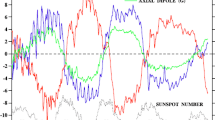Abstract
The distribution of magnetic fields of positive and negative polarities over the surface of the Sun was studied on the basis of synoptic maps presented by the NSO/Kitt Peak (1978 – 2016). To emphasize the contribution of weak fields the following transformation of synoptic maps was made: for each synoptic map only magnetic fields with a modulus less than 5 G (\(|B|\leq 5~\text{G}\)) were left unchanged, while larger or smaller fields were replaced by the corresponding threshold values +5 G or \(-5~\text{G}\). Cyclic variations of the magnetic-field polarity have been observed associated with two types of magnetic-field flows in the photosphere. Rush-to-the-poles (RTTP) appear near the maximum of solar activity and have the same sign as the following sunspots. The lifetime of RTTP is ∼ 3 yr, during which time they drift from latitudes 30 – \(40^{\circ}\) to the pole, causing the polarity change of the Sun’s polar field. Our aim is the study of another type of variation that has the form of series of flows with individual flows of 0.5 – 1 yr with alternating polarity. These flows, called “ripples” by Ulrich and Tran (Astrophys. J. 768, 189, 2013), are located in time between two RTTP and drift from the equator to latitudes of \({\sim}\, 50^{\circ}\). The period of variation of ripples was shown to be 1.1 yr for the northern hemisphere and 1.3 yr for the southern hemisphere. It was found that the amplitude of the variation was higher for the time intervals where the polar field had a positive sign. Within the same flow, fields of positive and negative signs developed in antiphase. Two types of flow – RTTP and ripples – together formed a unique structure that had a close connection to the magnetic solar cycle.
















Similar content being viewed by others
References
Altrock, R.C.: 1997, Solar Phys. 170, 411.
Altrock, R.C.: 2014, Solar Phys. 289, 623.
Bai, T.: 2003, Astrophys. J. 585, 1114.
Ballester, J.L., Oliver, R., Carbonell, M.: 2005, Astron. Astrophys. 431, L5.
Bigazzi, A., Ruzmaikin, A.: 2004, Astrophys. J. 604, 944.
Cliver, E.W.: 2014, Space Sci. Rev. 186, 169.
Deng, L.H., Xiang, Y.Y., Qu, Z.N., An, J.M.: 2016, Astron. J. 151, 70.
Gaizauskas, V.: 1993, In: Zirin, H., Ai, G., Wang, H. (eds.) The Magnetic and Velocity Fields of Solar Active Regions, ASP Conference Series 46, 479.
Getachew, T., Virtanen, I., Mursula, K.: 2019a, Astrophys. J. 874, 116.
Getachew, T., Virtanen, I., Mursula, K.: 2019b, Geophys. Res. Lett. 46, 9327.
Gopalswamy, N., Yashiro, S., Akiyama, S.: 2016, Astrophys. J. Lett. 823, L15.
Harvey, J.: 1996. http://www.noao.edu/noao/staff/jharvey/pole.ps.
Jin, C.L., Wang, J.X.: 2014, J. Geophys. Res. Space Phys. 119, 11.
Mordvinov, A.V., Pevtsov, A.A., Bertello, L., Petrie, G.J.D.: 2016, Solar-Terr. Phys. 2(1), 3.
Mursula, K., Getachew, T., Virtanen, I.I.: 2021, Astron. Astrophys. 645, id.A47.
Petrie, G.J.D.: 2015, Living Rev. Solar Phys. 12, 5.
Pishkalo, M.I.: 2019, Solar Phys. 294, 137.
Sun, X., Hoeksema, J.T., Liu, Y., Zhao, J.: 2015, Astrophys. J. 798, 114.
Ulrich, R.K., Tran, T.: 2013, Astrophys. J. 768, 189.
Vecchio, A., Laurenza, M., Meduri, D., Carbone, V., Storini, M.: 2012, Astrophys. J. 749, 27.
Vernova, E.S., Tyasto, M.I., Baranov, D.G.: 2022, Geomagn. Aeron. 62(7), 945. DOI.
Vernova, E.S., Tyasto, M.I., Baranov, D.G., Danilova, O.A.: 2018a, Geomagn. Aeron. 58(8), 1136.
Vernova, E.S., Tyasto, M.I., Baranov, D.G., Danilova, O.A.: 2018b, Solar Phys. 293(12), id 158.
Wang, Z.-F., Jiang, J., Wang, J.-X.: 2022, Astrophys. J. 930, 84.
Yeates, A.R., Baker, D., van Driel-Gesztelyi, L.: 2015, Solar Phys. 290, 3189.
Acknowledgments
The NSO/Kitt Peak data used here are produced cooperatively by NSF/NOAO, NASA/GSFC, and NOAA/SEL. Data acquired by SOLIS instruments were operated by NISP/NSO/AURA/NSF. The Wilcox Solar Observatory data used in this study were obtained via the web site http://wso.stanford.edu, courtesy of J.T. Hoeksema. This study includes data from the synoptic program at the 150-Foot Solar Tower of the Mt. Wilson Observatory. The Mt. Wilson 150-Foot Solar Tower is operated by UCLA, with funding from NASA, ONR, and NSF, under agreement with the Mt. Wilson Institute. The authors thank the reviewer for the thorough reading of the paper and useful remarks.
Author information
Authors and Affiliations
Contributions
All authors made equal contributions. All authors reviewed the manuscript.
Corresponding author
Ethics declarations
Competing interests
The authors declare no competing interests.
Additional information
Publisher’s Note
Springer Nature remains neutral with regard to jurisdictional claims in published maps and institutional affiliations.
Rights and permissions
Springer Nature or its licensor (e.g. a society or other partner) holds exclusive rights to this article under a publishing agreement with the author(s) or other rightsholder(s); author self-archiving of the accepted manuscript version of this article is solely governed by the terms of such publishing agreement and applicable law.
About this article
Cite this article
Vernova, E.S., Tyasto, M.I. & Baranov, D.G. Ripples and Rush-to-the-Poles in the Photospheric Magnetic Field. Sol Phys 298, 69 (2023). https://doi.org/10.1007/s11207-023-02164-z
Received:
Accepted:
Published:
DOI: https://doi.org/10.1007/s11207-023-02164-z




